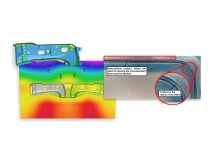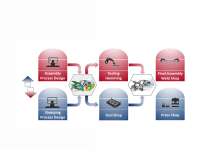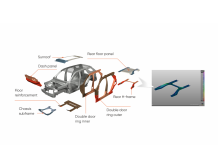
The automotive industry, across the entire world, has reached a turning point. No matter where you produce and no matter where you sell, greenhouse gas and pollution emissions are becoming crucial ‘driving’ factors in the car and truck body engineering processes.
According to the data published by the European Commission, transportation generates almost 25% of the total greenhouse gas (GHG) emission and it is the main cause of air pollution in the European cities. Just recently (November 2017), the European commission proposed new targets to accelerate the transition to low and zero emission vehicles for passenger cars and vans. GHG emission should reach 95g/kg by 2021
According to the United States’ Environmental Protection Agency (EPA), 27% of total greenhouse gas emissions in the USA is caused by transportation, as demonstrated in below chart. Vehicles are responsible for over 80% of this share (including light, medium and heavy trucks). The US CAFE (Corporate Average Fuel Economy) regulation requires vehicles to reach at least 54.5 mpg by 2025.

If we take a look at the global numbers we see that transportation represents 14% of total emissions worldwide, and almost 95% of the fuel is fossil fuel.

All economic sectors are affected by the plan for reduction of the global emissions. Therefore the question regarding “transportation” is how can emissions be limited? And focusing a bit more upon our own field, how are the new targets going to specifically influence the car body engineering process?
It is quite obvious that GHG and pollution emissions are directly connected to the type of fuel used and to the weight of the vehicles. In order to reduce emissions we have to use a “cleaner” energy sources but and also lighter cars (less energy consumed per travelled kilometer, usually measured in liter/100km or mpg). According to recent studies, 100 kg in weight reduction result in fuel savings of 0.3 L/100km for cars and 0.4 L/100km for light trucks.
Specifically in China, representing the country with the highest emission of GHG and pollution (see below), has set ambitious targets to become the world leader in new energy vehicle technology NEV and light weighting.

Taking a strong stance, the Chinese government now requires 8% of vehicle makers’ sales to be from NEV (new energy vehicles/electric) by 2019, with a target of selling two million such cars per year by 2020, and to account for 20% of sales by 2025! The fact is a new NEV has been launched literally every few weeks over the last year. Volkswagen also announced they’ll bring some forty new NEV car models to the Chinese market by 2025.[1]
In light of such commitments the “China New Energy Vehicle Parts Lightweight Innovative Technology Forum and exhibition 2018” took place in Shanghai this January. Speakers from FAW, Weltmeister Motor, Geely, Harbin Institute of Technology, etc. introduced different innovative aspects of new energy vehicle (NEV) technology at this conference.
AutoForm, as leader of the Sheet Metal Forming Process simulation, was invited to the conference to talk about the challenges in reducing the weight of car and truck bodies during the engineering of individual metal parts that make up the whole vehicle.
Christoph Weber, Business Development Manager, and Dr. Ethan Zhou, Sales Director AutoForm China, presented “Pushing lightweight boundaries with Digital Process Planning by AutoForm”.

Some 50% of weight saving potential of a vehicle is in its body-in-white (BIW). There are several materials like Aluminum, High Strength Steels (HHS) or Ultra High Strength Steel (UHSS) and different technologies like Hotforming or Hydroforming available today. Applying the right material and technology at the right place can successfully reduce weight for higher fuel efficiency while providing high strength and crash safety of vehicles. However, each of these technical options comes with challenges such as higher material springback and more sensitive production processes which cannot be handled efficiently with conventional methods.
During the presentation, several examples were shared regarding how a “Comprehensive Digital Process Planning” tackles these challenges and allows operators to achieve the best results in light-weighting while still meeting project deadlines and cost budgets. Only comprehensive digital tools enable to identify and solve issues early on and share consistent information efficiently over the entire value chain.

More than 250 automotive OEMs industry experts where present from China and representatives from the rest of the world attended the conference.
Participants showed great interest in the topic and asked several questions during the final Q&A session, especially about the use aluminum and it’s forming process. On this subject Mr. Weber discussed an example from Constellium of warm formed 7xxx aluminum alloys. The accurate process prediction of AutoForm-ThermoSolver enabled Constellium to successfully produce a B-pillar with significantly lower weight and higher strength.

During the Panel Discussion, the statement of Mr. Minqian Chen, Chief Engineer, SAIC Motors, (center person on the couch on the above picture) came up to support the concept of the comprehensive digital process planning. He stated that his company, SAIC, intends to use more advanced CAE simulation like AutoForm to reach their ambitious targets.
Leveraging complete digital transformation to push light weighting boundaries is a chance to out-perform competition, especially for new energy vehicle OEMs, since they are often younger and smaller organizations, which tend to be more flexible and eager to adopt the change.
Thank you for reading our blog, and stay tuned for more
Sources:
European Commission website
United States Environmental Protection Agency – EPA website
Light Weighting World Magazine
[1] http://money.cnn.com/2017/11/16/investing/volkswagen-electric-vehicles-china/index.html













